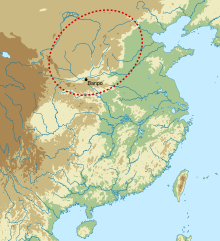
Back Yanşao mədəniyyəti Azerbaijani Яншаа Byelorussian Cultura de Yangshao Catalan Yangshao-Kultur German Πολιτισμός Γιανγκσάο Greek Jangŝao-kulturo Esperanto Cultura de Yangshao Spanish فرهنگ یانگشائو Persian Yangshaon kulttuuri Finnish Culture de Yangshao French
 | |||||||
| Geographical range | Middle reaches of Yellow River | ||||||
|---|---|---|---|---|---|---|---|
| Period | Neolithic | ||||||
| Dates | c. 5000 – c. 3000 BC | ||||||
| Major sites | Shuanghuaishu, Banpo, Jiangzhai | ||||||
| Preceded by | Peiligang culture, Baijia culture, Dadiwan culture, Cishan culture | ||||||
| Followed by | Majiayao (3300–2000 BCE) Longshan culture (3000-1900 BCE) | ||||||
| Chinese name | |||||||
| Chinese | 仰韶文化 | ||||||
| |||||||
The Yangshao culture (Chinese: 仰韶文化; pinyin: Yǎngsháo wénhuà) was a Neolithic culture that existed extensively along the middle reaches of the Yellow River in China from around 5000 BC to 3000 BC. The culture is named after the Yangshao site, the first excavated site of this culture, which was discovered in 1921 in the town of Yangshao in western Henan by the Swedish geologist Johan Gunnar Andersson (1874–1960).[1] The culture flourished mainly in Henan, as well as the neighboring provinces of Shaanxi and Shanxi.
Recent research indicates a common origin and spread of the Sino-Tibetan languages with the Cishan, Yangshao and/or Majiayao cultures.[2][3][4][5]

- ^ "Yangshao Culture Museum". Archived from the original on 2018-04-13. Retrieved 2018-04-13.
- ^ Zhang, Menghan; Yan, Shi; Pan, Wuyun; Jin, Li (24 April 2019). "Phylogenetic evidence for Sino-Tibetan origin in northern China in the Late Neolithic". Nature. 569 (7754): 112–115. Bibcode:2019Natur.569..112Z. doi:10.1038/s41586-019-1153-z. PMID 31019300. S2CID 129946000.
- ^ Bradley, David (27–28 October 2018). "Subgrouping of the Sino-Tibetan languages". 10th International Conference on Evolutionary Linguistics, Nanjing University.
- ^ LaPolla, Randy (2019). "The origin and spread of the Sino-Tibetan language family". Nature. 569 (7754): 45–47. Bibcode:2019Natur.569...45L. doi:10.1038/d41586-019-01214-6. ISSN 0028-0836. PMID 31036967.
- ^ a b Sagart et al. (2019), pp. 10319–10320.